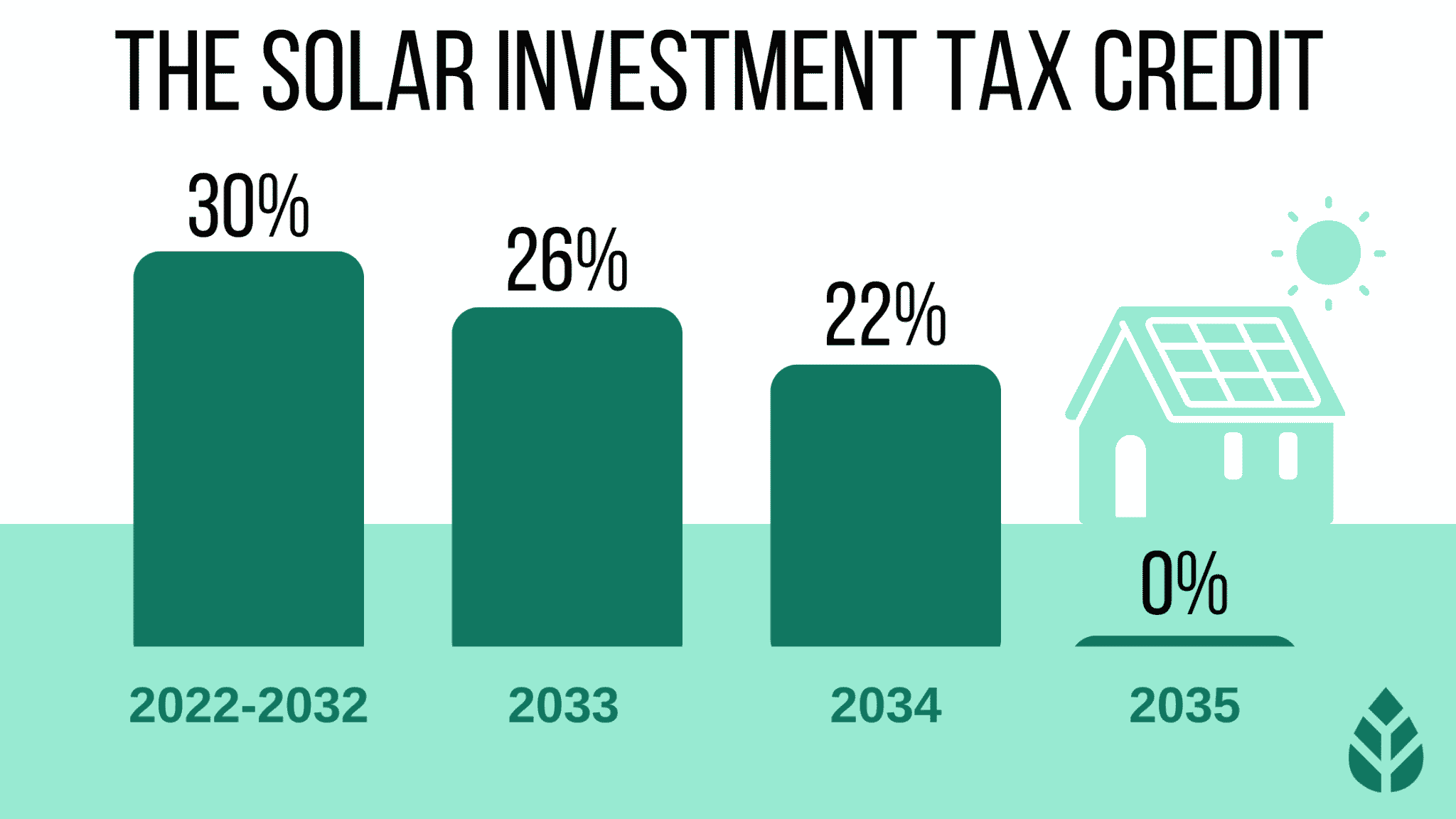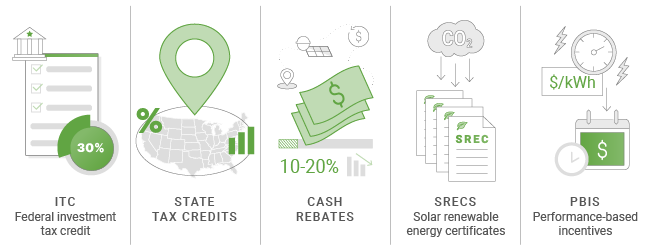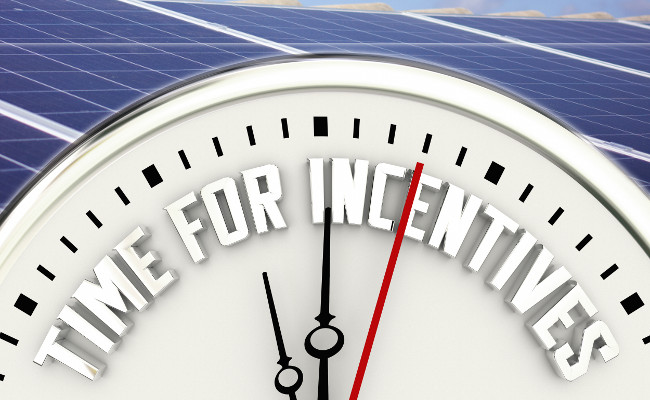The Residential Clean Energy Credit:
The Residential Clean Energy Credit is a solar tax credit that’s like a coupon for 30% off your home solar installation, backed and funded by the federal government. In the year that you install solar, the Residential Clean Energy Credit can greatly reduce or even eliminate the taxes that you would have otherwise owed to the federal government.
The Residential Clean Energy Credit is the current name of the solar tax credit that was originally known as The Investment Tax Credit (ITC) and created by the Energy Policy Act of 2005.
The Federal Solar Tax Credit:
The federal solar tax credit is an investment tax credit, or ITC. That basically means it’s an incentive meant to investment in something the government wants to support. Although the program is often referred to simply as the solar tax credit, its official name is the residential clean energy tax credit. The credit can cover expenses such as equipment and installation, but it doesn’t apply to structural work made solely to support panels. In some cases, the solar tax credit can be combined with state incentives and utility-funded programs that support clean energy.
The amount available for solar tax credits can vary, depending on what you spent on the project and when you completed it. But these solar incentives should be available in some form to homeowners who place a qualifying system in service anytime between 2017 and 2034.
Here’s A Timeline Of The ITC:

- 2016 – 2019: The ITC was 30% of the cost of installing a system.
- 2020 – 2021: Homeowners and businesses that installed new systems received a 26% credit.
- 2022 – 2032: The IRA passed and the ITC increased once again. Homeowners who install new systems can deduct 30% of the cost from their federal taxes. Commercial solar systems will be eligible for a 30% federal tax credit through 2025, when the U.S. Department of Treasury will decide whether or not to continue this benefit for commercial systems.
- 2033: The ITC will be reduced to 26%.
- 2034: Those who install a new system will receive a 22% credit.
- 2035: There is no federal credit planned at this point for residential solar energy systems starting this year.
Is The Solar Tax Credit Refundable?
No. The solar tax credit can save you money on your tax bill, but the amount of your credit can’t exceed the total amount you owe. That’s because the credit is “non-refundable,” in tax speak. Put simply, if the credit reduces your overall tax bill below zero, the IRS is not going to cut you a check for the difference. You can, however, “carry forward” any unused portion of your tax credit and use it to reduce your taxes in the following year.
How Do You Claim The Solar Tax Credit?
To claim the solar tax credit when you file a tax return, you’ll have to fill out IRS Form 5695, which covers residential energy projects.
You’ll need some information about your tax situation that you can gather from other documents, including Form 1040. You’ll also have to supply details about the cost of your energy project as well as a certification from the equipment manufacturer that the products qualify for the credit.
List of Solar Power Incentives:

- Investment tax credits
- State tax credits
- Cash rebates
- Net metering
- Solar renewable energy credits (SRECs)
- Performance-based initiatives
- Incentives for businesses
- Subsidized loans
- Tax exemptions
What States Have The Best Solar Incentives?
Each state has a different mix of tax credits, rebates and net-metering policies that can offset the cost of a solar installation.
“The economics, even without the tax credit, makes sense,” Fasullo said of installing solar on your home. But these programs can sweeten the pot even more.
Here are the top seven states for solar incentives:
1. New York
Residents in New York can access a few different incentives. On the tax credit side, customers qualify for 25% of the solar system cost, up to $5,000. They can also qualify for sales tax exemptions, and if your solar panels generate excess power, net metering will pay you about $0.69 to $1.09 per kilowatt per month.
2. Idaho
Homeowners in Idaho can qualify for some significant rebates. The state offers a tax deduction of 40% of the cost of a solar system applied the year of installation, then a 20% deduction the following three years. Net metering policies will vary by utility, but the state also offers low-interest loans to help fund solar installations.
3. Illinois
Illinois is another state where, if you fall into the income requirements, you could qualify for a free solar installation. Other incentives include renewable energy credits that could cover about a third of the cost of a system, and property tax adjustments to lower your tax bill.
4. Maryland
Maryland residents have a few solar tax incentive options. Lower income customers can have the total cost of a solar installation covered by grants. The state also offers exemptions from sales tax and property tax increases. Net metering and solar renewable energy certificates in the state allow homeowners to gain extra income from the energy their panels generate, too.
5. Oregon
In Oregon, the incentives you can expect depend somewhat on your utility provider. Anyone in the state can access up to $5,000 off the cost of qualifying solar systems. But utility companies also offer rebates of as much as $1,500, as well as net-metering opportunities. Customers building new homes can also get an incentive to throw solar on the roof.
6. South Carolina
The South Carolina Solar Tax Credit is one of the most generous out there. It offers a tax credit of 25% of the cost of a solar panel system, up to $35,000 or 50% of the taxpayer’s tax liability for the year. The state also offers some property tax exemptions and net metering programs. Plus, Santee Cooper customers can qualify for another $5,700 rebate.
7. Texas
The state of Texas has a big range of solar incentives that depend a lot on where you live and who your energy provider is (the state’s energy system is deregulated, meaning customers can choose their utility). Some of the available rebates include a $2,500 credit for customers in Austin, as well as net metering programs that vary by utility.
Why Now Is The Best Time To Install Solar Panels:
The Residential Clean Energy Credit getting increased to 30% means that now is a great time to go solar. You can take advantage of additional savings, and move toward an electrified future for all of your home’s energy needs. This landmark legislation shows our government’s commitment to supporting the clean energy economy, and is a clear sign to homeowners that now is the right time to install solar panels.
The solar tax credit has been a major driver of solar industry growth, and for many homeowners, the price difference of a solar power system with and without that tax credit is going to be significant. That’s why there’s never been a better time to go solar and take advantage of the maximum amount of the tax credit that’s still available while you can.



Recent Comments